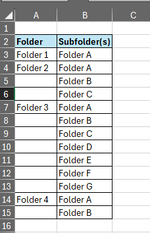Hi all, I need Excel to list all of the folders in a stated network location and then - in the next column - list all of the subfolders within them, but only to one subfolder level.
I have been using this code for a while, found on Mr. Excel a couple of years ago and originally submitted by John_w. I have made minor changes.
This code is great as it will loop through each and every subfolder, adding it to the sheet, but the folder structure has grown considerably since I first set this up and I now only need the first level of folders listed.
I cannot figure out how to stipulate in VBA that the loop should end after the first sub folder is listed, and then move onto the next folder at that subfolder level. In basic terms, the output should be -- column A showing the root folder, and column B listing folders contained at the next level. Something like the attached snapshot.
This is the code:
I have been using this code for a while, found on Mr. Excel a couple of years ago and originally submitted by John_w. I have made minor changes.
This code is great as it will loop through each and every subfolder, adding it to the sheet, but the folder structure has grown considerably since I first set this up and I now only need the first level of folders listed.
I cannot figure out how to stipulate in VBA that the loop should end after the first sub folder is listed, and then move onto the next folder at that subfolder level. In basic terms, the output should be -- column A showing the root folder, and column B listing folders contained at the next level. Something like the attached snapshot.
This is the code:
VBA Code:
Option Explicit
Public Sub Main_List_Folders_and_Files()
With ActiveSheet
.Cells.Clear
List_Folders_and_Files "insert location here, removed for online forum", .Range("A3")
End With
End Sub
Private Function List_Folders_and_Files(folderPath As String, destCell As Range) As Long
Dim FSO As Object
Dim FSfolder As Object, FSsubfolder As Object, FSfile As Object
Dim folders As Collection, levels As Collection
Dim subfoldersColl As Collection
Dim n As Long, c As Long, i As Long
Set FSO = CreateObject("Scripting.FileSystemObject")
Set folders = New Collection
Set levels = New Collection
'Add start folder to stack'''''''''''''''''''''
folders.Add FSO.GetFolder(folderPath)
levels.Add 0
n = 0
Do While folders.Count > 0
'Remove next folder from top of stack'''''''''''''''
Set FSfolder = folders(folders.Count): folders.Remove folders.Count
c = levels(levels.Count): levels.Remove levels.Count
'Output this folder and its files'''''''''''''''''''''
destCell.Offset(n, c).Value = "'" & FSfolder.Name
n = n + 0
c = c + 1
For Each FSfile In FSfolder.Files
destCell.Offset(n, c).Value = "'" & FSfile.Name
n = n + 1
Next
'Get collection of subfolders in this folder ''
Set subfoldersColl = New Collection
For Each FSsubfolder In FSfolder.SubFolders
subfoldersColl.Add FSsubfolder
Next
'Loop through collection in reverse order and put each subfolder on top of stack. As a result, the subfolders are processed and
'output in the correct ascending ASCII order
For i = subfoldersColl.Count To 1 Step -1
If folders.Count = 0 Then
folders.Add subfoldersColl(i)
levels.Add c
Else
folders.Add subfoldersColl(i), , , folders.Count
levels.Add c, , , levels.Count
End If
Next
Set subfoldersColl = Nothing
Loop
List_Folders_and_Files = n
End Function





